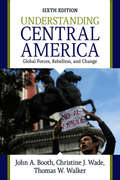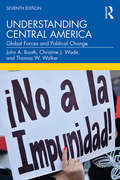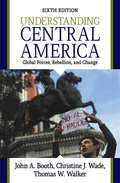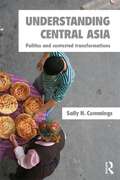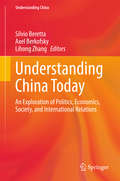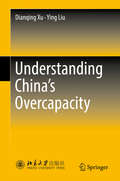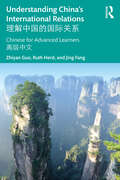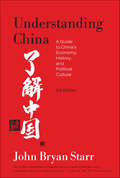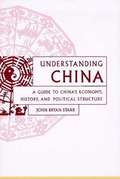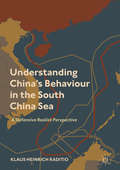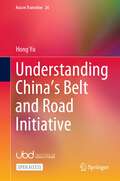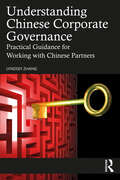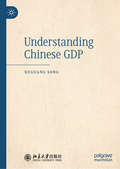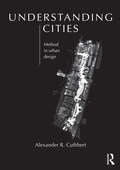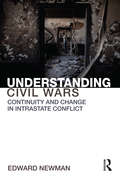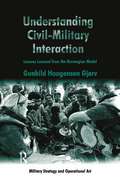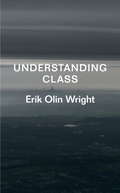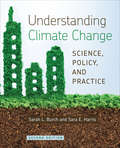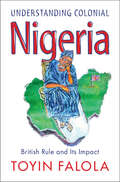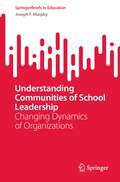- Table View
- List View
Understanding Central America
by Christine J. Wade John A. Booth Thomas W WalkerThis edition of Understanding Central America explains how domestic and global political and economic forces have shaped rebellion and regime change in Costa Rica, Nicaragua, El Salvador, Guatemala, and Honduras. John A. Booth, Christine J. Wade, and Thomas W. Walker explore the origins and development of the region's political conflicts and its efforts to resolve them. Covering the region's political and economic development from the early 1800s onward, the authors provide a background for understanding Central America's rebellion and regime change of the past forty years.
Understanding Central America
by Christine J. Wade John A. Booth Thomas WalkerUnderstanding Central America explains how domestic, global, political, and economic forces have shaped rebellion and regime change in Costa Rica, Nicaragua, El Salvador, Guatemala, and Honduras throughout their histories, during the often-turbulent 1970s and since. The authors explain the origins and development of the region’s political conflicts, their resolution and ongoing political change. This sixth edition provides analysis of citizens’ attitudes and participation through 2012 and up-to-date information on political changes in each of the five countries, including the 2013 and 2014 elections. Recent developments include dramatic changes in party systems in Honduras, Costa Rica, and Nicaragua; the extremely narrow victory of the newly elected FMLN president in El Salvador; and Guatemala’s prosecution of human rights abusers. This book is an essential resource, as it provides a comprehensive introduction to the region and a model for how to convey its complexities in accessible language.
Understanding Central America: Global Forces and Political Change
by Thomas W. Walker Christine J. Wade John A. BoothIn this seventh edition, John A. Booth, Christine J. Wade, and Thomas W. Walker update a classic in the field which invites students to explore the histories, economies, and politics of Costa Rica, Nicaragua, El Salvador, Guatemala, and Honduras. Covering the region's political and economic development from the early 1800s onward, the authors bring the Central American story up to date. New to the 7th Edition: Analysis of trends in human rights performance, political violence, and evolution of regime types; Updated findings from surveys to examine levels of political participation and support for democratic norms among Central Americans; Historical and current-era material on indigenous peoples and other racial minorities; Discussion of popular attitudes toward political rights for homosexuals, and LGBTQ access to public services; Discussion of women’s rights and access to reproductive health services, and women’s integration into elective offices; Tracing evolving party systems, national elections, and US policy toward the region under the Obama and Trump administrations; Central America’s international concerns including Venezuela’s shrinking role as an alternative source of foreign aid and antagonist to US policy in the region, and migration among and through Central American nations. Understanding Central America is an ideal text for all students of Latin American politics and is highly recommended for courses on Central American politics, social systems, and history.
Understanding Central America: Global Forces, Rebellion, and Change
by John A. BoothUnderstanding Central America explains how domestic, global, political and economic forces have shaped rebellion and regime change in Costa Rica, Nicaragua, El Salvador, Guatemala, and Honduras throughout their histories, during the often-turbulent 1970s and since. The text provides students a comprehensive coverage of Central America, political science, and international relations. The authors explain the origins and development of the region's political conflicts, their resolution and ongoing political change. This Sixth Edition provides the most up-to-date information on the recent political changes in each of the five countries presented.
Understanding Central Asia: Politics and Contested Transformations
by Sally N. CummingsSince Soviet collapse, the independent republics of Kazakhstan, Kyrgyzstan, Tajikistan, Turkmenistan and Uzbekistan have faced tremendous political, economic, and security challenges. Focusing on these five republics, this textbook analyzes the contending understandings of the politics of the past, present and future transformations of Central Asia, including its place in international security and world politics. Analysing the transformation that independence has brought and tracing the geography, history, culture, identity, institutions and economics of Central Asia, it locates ‘the political’ in the region. A comprehensive examination of the politics of Central Asia, this insightful book is of interest both to undergraduate and graduate students of Asian Politics, Post-Communist Politics, Comparative Politics and International Relations, and to scholars and professionals in the region.
Understanding Children's Personal Lives and Relationships (Palgrave Macmillan Studies in Family and Intimate Life)
by Hayley DaviesInformed by ethnographic research with children, Davies offers new sociological insights into children's personal relationships, as well as closely examining methodological approaches to researching with children and researching relationships.
Understanding China Today
by Silvio Beretta Axel Berkofsky Lihong ZhangThis book covers numerous areas and aspects of Chinese domestic and external politics and policies, the Chinese economy, Chinese society and culture, and Chinese literature and history. It is divided into four sections, the first of which focuses on China's place in world politics, including its relations with the European Union, Russia, India, Japan, the United States, and Africa. The second section addresses features of China's role in the international economy, with discussion of its outward economic strategy, the significance of Chinese multinationals in Europe, and the experiences of Italian banks and companies in China. The final two sections are devoted to Chinese politics and society, and Italian views on Chinese culture, language, and literature. The volume is multidisciplinary in nature, with contributions from experts in politics, economics, history, law, literature, gender studies, and the media. It will appeal to a wide range of China scholars and analysts as well as to all who have an interest in international relations, Chinese politics, the Chinese economy, and Chinese society, culture, literature, and history.
Understanding China's Overcapacity
by Ying Liu Dianqing XuThis book analyzes of the surplus of production capacity in China. According to a government statement, there is a serious surplus of productive capacity in the steel, cement, glass, aluminum, and shipbuilding industries. There was no surplus of productive capacity in above industries between 2002 and 2012, and the current surplus is due to poor government policies on real estate prices after 2012. The book argues that if the Chinese government invested more in social welfare housing over the next few years the surplus of productive capacity would very soon disappear.
Understanding China's International Relations 理解中国的国际关系: Chinese for Advanced Learners 高级中文
by Zhiyan Guo Jing Fang Ruth HerdChina’s influence on the international stage has grown significantly over recent decades. Alongside the rapid development of its economy, the country has come to play a key role within the global configuration of politics and diplomacy. It has therefore become vital that students of Chinese acquire advanced language skills. This book familiarises students with the use of the formal register, allowing them to extend their proficiency to the advanced level in the skills of reading, writing, speaking, and listening. In this way, students may also increase their understanding of China’s cultural heritage, politics, and international relations.The texts chosen are written in a variety of styles and employ various forms of Chinese discourse in order that students may achieve greater breadth and depth in their knowledge of grammar and syntax. Moreover, students will find that there is ample opportunity to develop the tools with which to express opinions appropriately, both orally and in writing. The selection of materials in the book has been based on the CEFR (Common European Framework for Reference) B2 and above, the Advanced level of ACTFL (American Council on the Teaching of Foreign Languages), and Grades 5 (HSK 5) and above of the newly-published version of the Chinese Proficiency Grading Standards for International Chinese Language Education. Full audio is available online.
Understanding China's New Common Prosperity: Significance, Connotations, and Goals
by Song Yang Liu Yuanchun Wang Fei Zhou GuangsuThis book explains China's new common prosperity policies—their significance, connotations, and goals—and explains the economic logic behind these often misunderstood policies. First, the authors explain the theory behind common prosperity. Why is the Chinese government changing its economic policies now, and what is its objectives and metrics? The authors then go on to explain how the new policies are being designed, what the test cases are across the country, and how the government, businesses, families, and individuals are working together to promote common prosperity. An important book that will help scholars around the world understand China's new economic bottom line. This book will be of interest to economists, sociologists, and sinologists.
Understanding China: A Guide to China's Economy, History, and Political Culture
by John Bryan StarrAfter ten years, John Bryan Starr has thoroughly revised and updated his classic introduction to the background of, the data about, and the issues at stake in China's present and future. In the new edition, Starr seamlessly weaves in additional material on the 2008 Olympics in Beijing, the Chinese government's ongoing efforts to curb the influence of the Internet, and the intensifying trade disputes between the United States and China. Succinct, modest, and refreshingly forthright, Understanding China remains a necessary guide for the uninitiated to everything from the Chinese economy and political system, to its intellectual freedoms and human rights, to its relationship with the rest of the world.
Understanding China: A Guide to China's Economy, History, and Political Structure
by John BryanAn introduction to China's economics and political system.
Understanding China’s Behaviour in the South China Sea: A Defensive Realist Perspective
by Klaus Heinrich RaditioThis book analyses the origins of security dilemmas in the South China Sea (SCS) and the significance of China’s actions in asserting its claim from the perspective of defensive realist theory. In its analysis, the book argues that security dilemmas in the SCS first arose between China and other SCS claimants, and then between China and the United States. Research in this book provides significant support to the defensive realist theory vis-à-vis offensive realism. It encourages adopting a reassurance policy to reach a peaceful resolution to the SCS disputes between China, the other claimants, and the United States. The book will be useful for policymakers, academics, researchers and students.
Understanding China’s Belt and Road Initiative (Asia in Transition #26)
by Hong YuThis open access book provokes critical thinking regarding the most ambitious Chinese project since the founding of the People’s Republic of China, The Belt and Road Initiative (BRI). The book presents extensive quality research and original insights in assessing the status of China’s outbound investment and construction projects under the BRI umbrella. Referring to case studies and projects of selected countries from Southeast Asia, Central Asia, and the Middle East, the author sheds new light on the issues and problems associated with the BRI's implementation and discusses both the readjustments and prospects for the BRI. Finally, this book demarcates the limits and potential of the world’s second largest economy in pushing for the BRI, which is challenged by enormous domestic tensions and external pressures. It also identifies and analyzes potential new collaboration areas between the Belt and Road countries and China under the BRI framework in the context of the post-COVID-19 era. It provides an outstanding reference for academics, students, policymakers, and the business community working in areas of international affairs and Asian economics and development, particularly those interested in Sino-relations and Chinese power dynamics in the global world order.
Understanding Chinese Corporate Governance: Practical Guidance for Working with Chinese Partners
by Lyndsey ZhangIn a complex political and environmental global landscape, it has never been more critical for global organizations to understand the past, present, and future of Chinese corporate governance: this book is the key. Leveraging her dual-cultural background and using a board-level practitioner’s lens, Lyndsey Zhang offers insights that will help the global business community better understand Chinese companies’ corporate governance practices and economic development journeys, shorten the learning curve for global business leaders and investors, and explore different economic models that better suit emerging markets. She addresses important questions such as: • How does the Chinese government manage to retain its controlling position in Chinese companies while still making them attractive to global investors? • What are the drivers for Chinese companies’ future corporate governance improvement? • What is China’s position on the worldwide ESG and climate change movements? • How can global practitioners feel less like "navigating in the dark" when working with Chinese companies? This book will be an invaluable resource for anyone seeking to understand the rapidly changing world of Chinese corporate governance, including global investors, senior executives in multinational corporations, consultants, financial and political policymakers, business and law students, and researchers.
Understanding Chinese GDP
by Xuguang SongThis book provides in-depth analyses on accounting methods of GDP, statistic calibers and comparative perspectives on Chinese GDP. Beginning with an exploration of international comparisons of GDP, the book introduces the theoretical backgrounds, data sources, algorithms of the exchange rate method and the purchasing power parity method and discusses the advantages, disadvantages, and the latest developments in the two methods. This book further elaborates on the reasons for the imperfections of the Chinese GDP data including limitations of current statistical techniques and the accounting system, as well as the relatively confusing statistics for the service industry. The authors then make suggestions for improvement. Finally, the authors emphasize that evaluation of a country’s economy and social development should not be solely limited to GDP, but should focus more on indicators of the comprehensive national power, national welfare, and the people’s livelihood. This book will be of interest to economists, China-watchers, and scholars of geopolitics.
Understanding Cities: Method in Urban Design
by Alexander CuthbertUnderstanding Cities is richly textured, complex and challenging. It creates the vital link between urban design theory and praxis and opens the required methodological gateway to a new and unified field of urban design. Using spatial political economy as his most important reference point, Alexander Cuthbert both interrogates and challenges mainstream urban design and provides an alternative and viable comprehensive framework for a new synthesis. He rejects the idea of yet another theory in urban design, and chooses instead to construct the necessary intellectual and conceptual scaffolding for what he terms 'The New Urban Design'. Building both on Michel de Certeau's concept of heterology – 'thinking about thinking' – and on the framework of his previous books Designing Cities and The Form of Cities, Cuthbert uses his prior adopted framework – history, philosophy, politics, culture, gender, environment, aesthetics, typologies and pragmatics – to create three integrated texts. Overall, the trilogy allows a new field of urban design to emerge. Pre-existing and new knowledge are integrated across all three volumes, of which Understanding Cities is the culminating text.
Understanding Civil Wars: Continuity and change in intrastate conflict (Routledge Studies in Civil Wars and Intra-State Conflict)
by Edward NewmanThis volume explores the nature of civil war in the modern world and in historical perspective. Civil wars represent the principal form of armed conflict since the end of the Second World War, and certainly in the contemporary era. The nature and impact of civil wars suggests that these conflicts reflect and are also a driving force for major societal change. In this sense, Understanding Civil Wars: Continuity and change in intrastate conflict argues that the nature of civil war is not fundamentally changing in nature. The book includes a thorough consideration of patterns and types of intrastate conflict and debates relating to the causes, impact, and ‘changing nature’ of war. A key focus is on the political and social driving forces of such conflict and its societal meanings, significance and consequences. The author also explores methodological and epistemological challenges related to studying and understanding intrastate war. A range of questions and debates are addressed. What is the current knowledge regarding the causes and nature of armed intrastate conflict? Is it possible to produce general, cross-national theories on civil war which have broad explanatory relevance? Is the concept of ‘civil wars’ empirically meaningful in an era of globalization and transnational war? Has intrastate conflict fundamentally changed in nature? Are there historical patterns in different types of intrastate conflict? What are the most interesting methodological trends and debates in the study of armed intrastate conflict? How are narratives about the causes and nature of civil wars constructed around ideas such as ethnic conflict, separatist conflict and resource conflict? This book will be of much interest to students of civil wars, intrastate conflict, security studies and international relations in general.
Understanding Civil-Military Interaction: Lessons Learned from the Norwegian Model (Military Strategy and Operational Art)
by Gunhild Hoogensen GjørvA novel examination of civil-military interaction in particular between militaries and humanitarian actors, in light of the so-called 'Norwegian model' that espouses a clear divide between political and humanitarian (or military and civilian - the model is in fact unclear) actors, while maintaining a tight coordination between them. The Norwegian government has significantly reduced their own military's capacity in the field of civil-military interaction, raising the question as to whether knowledge and skills in this field are necessary. Using a multi-actor security framework, this book examines whether or not the Norwegian government is correct in its assumptions (about both the model and civil-military knowledge amongst military personnel) and concludes that the Norwegian model is a well-meaning but inefficient and problematic model in reality. Although the case study focuses on Norway, the lessons learned are relevant to all nations engaged in civil-military operations.
Understanding Class
by Erik Olin WrightLeading sociologist examines how different readings of class enrich our understanding of capitalismFew ideas are more contested today than "class." Some have declared its death, while others insist on its centrality to contemporary capitalism. It is said its relevance is limited to explaining individuals' economic conditions and opportunities, while at the same time argued that it is a structural feature of macro-power relations. In Understanding Class, leading left sociologist Erik Olin Wright interrogates the divergent meanings of this fundamental concept in order to develop a more integrated framework of class analysis. Beginning with the treatment of class in Marx and Weber, proceeding through the writings of Charles Tilly, Thomas Piketty, Guy Standing, and others, and finally examining how class struggle and class compromise play out in contemporary society, Understanding Class provides a compelling view of how to think about the complexity of class in the world today.From the Trade Paperback edition.
Understanding Climate Change
by Sarah Burch Sara HarrisConversations about climate change are filled with challenges involving complex data, deeply held values, and political issues. Understanding Climate Change provides readers with a concise, accessible, and holistic picture of the climate change problem, including both the scientific and human dimensions.Understanding Climate Change examines climate change as both a scientific and a public policy issue. Sarah L. Burch and Sara E. Harris explain the basics of the climate system, climate models and prediction, and human and biophysical impacts, as well as strategies for reducing greenhouse gas emissions, enhancing adaptability, and enabling climate change governance. The authors examine the connections between climate change and other pressing issues, such as human health, poverty, and other environmental problems, and they explore the ways that sustainable responses to climate change can simultaneously address those issues.An effective and integrated introduction to an urgent and controversial issue, Understanding Climate Change contains the tools needed for students, instructors, and decision-makers to become constructive participants in the human response to climate change.
Understanding Climate Change: Science, Policy, and Practice, Second Edition
by Sarah Burch Sara E. HarrisConversations about climate change are filled with challenges involving complex data, deeply held values, and political issues. Understanding Climate Change examines climate change as both a scientific and a public policy issue. Sarah L. Burch and Sara E. Harris explain the basics of the climate system, climate models and prediction, and human and biophysical impacts, as well as strategies for climate change adaptation and mitigation. The second edition has been fully updated throughout, including coverage of new advances in climate modelling and of the shifting landscape of renewable energy production and distribution. A brand new chapter discusses global governance, including the United Nations Framework Convention on Climate Change and the Paris Agreement, as well as mitigation efforts at the national and subnational levels. This new chapter makes the book even more relevant to climate change courses housed in social sciences departments such as political science and geography. An effective and integrated introduction to an urgent and controversial issue, this book is well-suited to adoption in a variety of introductory climate change courses found in a number of science and social science departments. Its ultimate goal is to equip readers with the tools needed to become constructive participants in the human response to climate change.
Understanding Colonial Nigeria: British Rule and Its Impact
by Toyin FalolaIn this landmark new history, Toyin Falola analyses the impact of Britain's colonization of Nigeria from the late nineteenth century to 1960, when the country regained independence. Falola covers major events in depth, from the initial conquest and denial of Indigenous sovereignty, to the emergence and functioning of the colonial state, and later nationalist movements, offering fascinating insights into labour and trade relations, regionalism and nationalism, and Nigeria's role during the First and Second World Wars. Understanding Colonial Nigeria assesses the economic, political, social, and cultural changes that culminated in the emergence of a coalition of diverse groups agitating for the end of colonial rule from the 1940s – from labor coalitions and politicians to youth groups and market women. From the country's borders and state structure, to the present conflicts, Falola powerfully reflects on the lasting consequences of British intervention in the affairs of Nigerian states and communities.
Understanding Commanders' Information Needs for Influence Operations
by Eric V. Larson Brian Nichiporuk Dalia Dassa Kaye Forrest E. Morgan Richard E. DarilekDocuments a study whose goals were to develop an understanding of commanders' information requirements for cultural and other "soft" factors in order to improve the effectiveness of combined arms operations, and to develop practical ways for commanders to integrate information and influence operations activities into combined arms planning/assessment in order to increase the usefulness to ground commanders of such operations.
Understanding Communities of School Leadership: Changing Dynamics of Organizations (SpringerBriefs in Education)
by Joseph F. MurphyThis book examines the evolution of schooling from bureaucracy and hierarchy to post-industrial schools, and places teachers’ leadership on center stage at the same time. That is, it asks teachers to deepen leadership in their classrooms and with other teachers. The book carries education and schooling from formal control to a social influence process and addresses the deeply rooted difficulty of focusing too much energy on content. It reveals the strong power of internal and external context and helps educators implant the idea of the school not as a fixed, immutable home, but as a relatively deep social process. It shows how co-leadership comes alive in schools. Communities of schooling is one of the three most critical developments in education in the last 140 years. When it is linked with the two other fundamental reorientations in schooling - “dispersed ownership” and “constructivist work” - it becomes the most powerful force in education since the 1700s. This book shows how communities of schooling replace the earlier pillars of “learning as telling,” “hierarchy of control,” and “non-democratic influence.” The work also explains the meaning and understanding of school work as a social influence process where all school-based educators exert power, but at different levels. The idea of enhancing individual and collective capacity through interdependency, shared work, and collective responsibility is unpacked.
